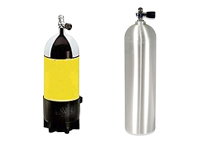Diving tank

Scuba tanks are made of steel or aluminium. For recreational diving they are commonly filled with compressed gas up to 210bar / 3000psi. For special use (ex. professional diving) there are high pressure tanks available which are filled to 300bar / 4400psi. Tanks are available in sizes between 2-20l. The most common used size is 12l.
There is a difference between steel and aluminium tanks.
Because aluminium is softer than steel, the tanks have thicker walls than steel tanks to stand the required pressure. This calls for different shapes. While the steel tanks are more compact, the aluminium cylinders have a smaller diameter and are longer. They are more prone to denting or scratching than steel tanks.
Steel tanks are a bit more expensive but are also more durable than aluminium tanks. They need proper maintenance because they are sensitive to moisture. The steel tanks may rust, if the fillings moisture levels are too high. As long as there is only slight oxidation, it can be removed by a special cleaning process, as soon there are small cavities, the tank has to be cleaned, inspected and hydro tested.
But apart from that both, the aluminium and the steel cylinders require a periodic visual inspection and hydro test.
Another difference determines the buoyancy of the tank. Steel tanks are heavier and this is why they are more negatively buoyant than aluminium tanks. For this reason, when the weight of the air becomes less at the end of the dives, the aluminium tanks start to float while the steel tanks still have negative buoyancy. To compensate that loss of weight, the diver has to carry additional weight when using aluminium cylinders.
If divers don’t want to buy their own tank, they should be aware that most diving centres operate with aluminium tanks as rental gear.
The different size and capacity should be taken into consideration when choosing a tank.
So it will probably be difficult for a small person to carry a 12l aluminium tank, because the valve might bang his head during the dive. If a diver is planning to do a special dive like deep dive or a dive with a long bottom time, it is advisable to choose a tank capacity according to his calculated air consumption.
To get advice ask the instructors, or share your opinions with other divers in the diving equipment forum.
Look at the diving center directory to find a dive shop or diving center in your region.
All information and opinions provided are general and no substitute for professional advice. Always check with your diving instructor what fits best to your personal needs and to your level of training.











